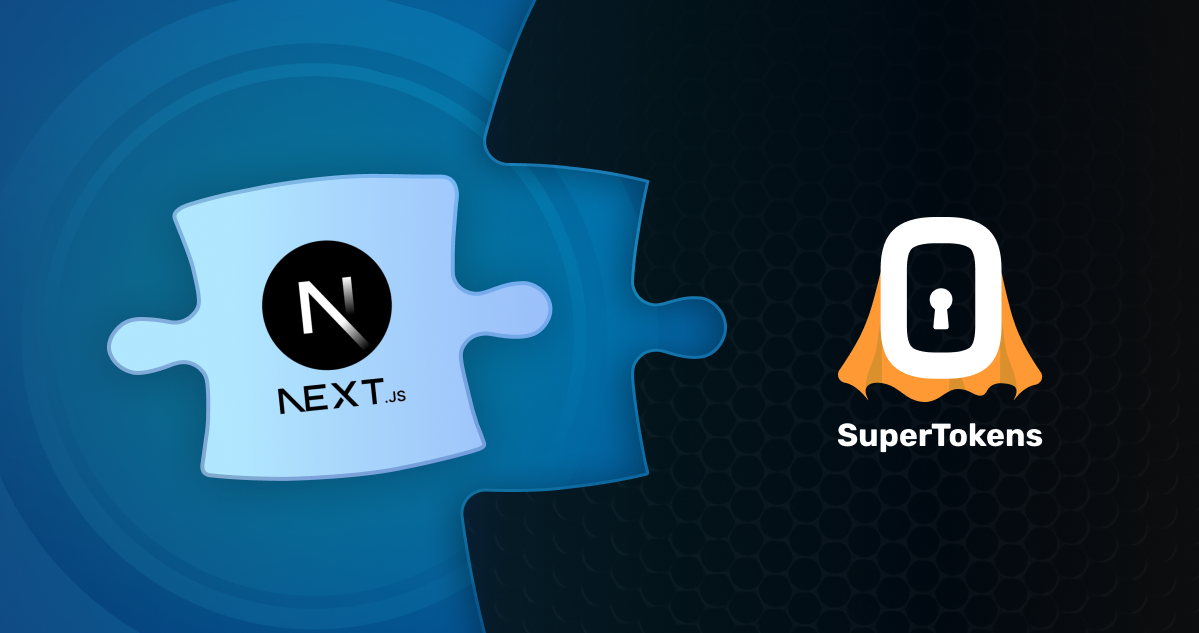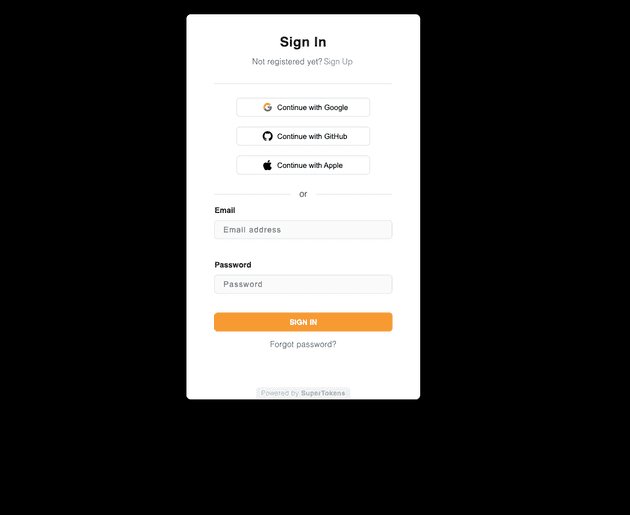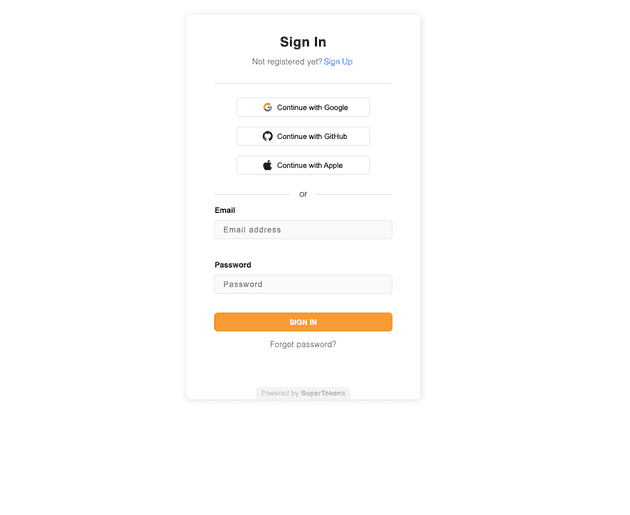Understanding Next.js
Next.js, a powerful React framework has rapidly gained popularity due to its versatility and ability to build both static and dynamic web applications.
Featuring server-side rendering (SSR) and static site generation (SSG) capabilities, Next.js makes creating and deploying websites easy with its tight integration with Vercel.
This article will cover how Next.js handles rendering and authentication, discuss some authentication strategies, and how to implement an authentication solution in Next.js.
Authentication in Next.js
While the concept of authentication and its strategies are the same for all JavaScript frameworks, including Nextjs, what sets Nextjs and other frameworks like it apart are the patterns available for preventing unauthenticated users from accessing protected routes, commonly referred to as authentication patterns.
To understand what authentication means for Nextjs, you must first understand how Nextjs renders things.
With Nextjs, three types of rendering are available: client-side rendering, server-side rendering, and static site generation.
-
CSR: With client side rendering, a minimal HTML file and the bundled JavaScript code are sent to the browser. The JavaScript is then executed in the browser to render the page.
-
SSR: With server-side rendering, as the name implies the full HTML for the page content is rendered on the server upon a user’s request and is then sent to the browser.
-
SSG: In static site generations the HTML for each page is generated at build time and sent to the browsers at the user’s request.
Authentication vs. Authorization in Next.js
Authentication and authorization are two crucial concepts in application security, but they serve two distinct purposes:
Authentication: Process that verifies the identity of a user, answering the question “Who are you?”. Authentication typically involves logging in with credentials (like username and password), or through a third-party service (like Google, Facebook, GitHub…).
Once authenticated, the user is recognized by the app, allowing access to resources tied to their account.
Authorization: Once the user is authenticated, authorization determines what they are allowed to do (comparable to permissions), answering the question “What action can you perform?”.
Authorization involves checking whether the authenticated user has the necessary permissions to access specific resources or perform certain actions. For example, an authenticated user might be authorized to view their profile, but not authorized to access the admin dashboard.
You can learn more about the differences between the two in our blog.
Nextjs Authentication Stratergies
There are two common authentication stratergies when preventing unauthenticated users from accessing proctected routes in Nextjs. These included static generation and server-side authentication and server-side authentication. It is important to choose the a stratergy that suits your application and requirements.
Static generation pattern
In Next.js, when a page doesn’t contain blocking functions such as getStaticProps and getInitialProps, it is automatically prerendered to static HTML. Based on this, for the static generation pattern, when a page is requested, a loading state that has been statically generated is first served, followed by an attempt to fetch a user’s data in the client.
If successful, the requested page is displayed. Otherwise, the user is redirected to the login page and will see errors explaining why the check failed.
This pattern has the disadvantage of displaying secure content to an unauthenticated user.
Server-side pattern
In this pattern, when the browser requests a server-side rendered page, a request is sent to the backend API to get a user session. If successful, the server pre-renders the requested page on the server and sends it to the browser; otherwise, the user is redirected to the login page.
Unlike the static generation pattern, with this pattern, there will be no flash of unauthenticated content (FOUC) or a need to use a loading indicator.
One disadvantage is that the rendering will be blocked until the backend API responds. This is because getServerSideProps is blocking until the request resolves.
Setting up Next.js Authentication with SuperTokens
(Recommended) Use create-supertokens-app
create-supertokens-app is a command line tool created by the SuperTokens team that lets you create new projects with SuperTokens already integrated. This is the fastest way to get started with SuperTokens. To use this tool, run the following command:
npx create-supertokens-app@latestThe tool will prompt you for your tech stack, you can choose between the app directory and the pages directory.
The rest of this article is relevant only if you are adding SuperTokens to your app manually and if you have not used the tool mentioned above. If you used create-supertokens-app, the setup is already complete and you can continue building the rest of the application. To know details about Next.js integration with SuperTokens, refer to their official documentation
Manually Setting up the Next.js project
Run the following command:
npx create-next-app <PROJECT_NAME>create-next-app will prompt you to select details about your project, for the sake of this example we are:
- Using Typescript
- Using ESLint
- Not using Tailwind CSS
- Not using the
src/directory - Using the App router
- Not using import aliases
After the tool has finished, you should have a basic Next.js app setup. You can run the project with npm run dev.
Installing and setting up SuperTokens
Install supertokens-auth-react and supertokens-node as node dependencies:
npm i supertokens-node supertokens-auth-reactIn this example, we are going to be using the Social login + email password recipe of SuperTokens.
Step 1: Initialise SuperTokens for our APIs
SuperTokens’ node SDK provides a set of APIs that we can use for logging in our users and managing their sessions. We will follow the quick setup guide to initialise the backend SDK. Create a /app/config/appinfo.ts file and add the following code to it:
export const appInfo = {
appName: 'SuperTokens Next.js demo app',
apiDomain: 'http://localhost:3000',
websiteDomain: 'http://localhost:3000',
apiBasePath: '/api/auth',
websiteBasePath: '/auth',
};apiDomaintells SuperTokens where the APIs are exposed fromwebsiteDomainis the base URL of the frontendapiBasePathis the path at which the backend SDK exposes all its APIswebsiteBasePathis the path where the frontend SDK will add its routes
Because Next.js serves both the frontend and backend on the same base URL, it is important to make sure that the apiBasePath and websiteBasePath are not the same.
Create a /app/config/backend.ts file and add the following code to it:
import SuperTokens from "supertokens-node";
import ThirdPartyEmailPassword from "supertokens-node/recipe/thirdpartyemailpassword";
import Session from "supertokens-node/recipe/session";
import { TypeInput } from "supertokens-node/types";
import { appInfo } from "./appinfo";
export const backendConfig = (): TypeInput => {
return {
appInfo,
supertokens: {
connectionURI: "https://try.supertokens.io",
},
recipeList: [
ThirdPartyEmailPassword.init({
/**
* These are development credentials provided by SuperTokens, make sure
* to use your own credentials when you deploy to production.
*/
providers: [
{
config: {
thirdPartyId: "google",
clients: [{
clientId: "1060725074195-kmeum4crr01uirfl2op9kd5acmi9jutn.apps.googleusercontent.com",
clientSecret: "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"
}]
}
},
{
config: {
thirdPartyId: "github",
clients: [{
clientId: "467101b197249757c71f",
clientSecret: "e97051221f4b6426e8fe8d51486396703012f5bd"
}]
}
},
{
config: {
thirdPartyId: "apple",
clients: [{
clientId: "4398792-io.supertokens.example.service",
additionalConfig: {
keyId: "7M48Y4RYDL",
privateKey:
"-----BEGIN PRIVATE KEY-----\nMIGTAgEAMBMGByqGSM49AgEGCCqGSM49AwEHBHkwdwIBAQQgu8gXs+XYkqXD6Ala9Sf/iJXzhbwcoG5dMh1OonpdJUmgCgYIKoZIzj0DAQehRANCAASfrvlFbFCYqn3I2zeknYXLwtH30JuOKestDbSfZYxZNMqhF/OzdZFTV0zc5u5s3eN+oCWbnvl0hM+9IW0UlkdA\n-----END PRIVATE KEY-----",
teamId: "YWQCXGJRJL",
}
}]
}
},
],
}),
Session.init(),
],
};
}
let initialized = false;
export function ensureSuperTokensInit() {
if (!initialized) {
SuperTokens.init(backendConfig());
initialized = true;
}
}The ThirdPartyEmailPassword recipe adds email password and social login to our project and the Session recipe adds the functionality of managing users sessions and refreshing their sessions.
In our APIs we will use ensureSuperTokensInit to make sure SuperTokens is initialised before we use any functionality from the SDK.
Also modify the dev script in the package.json to:
{
"scripts": {
"dev": "next dev -p 3000",
},
}We do this because in this example we want the project to run on port 3000, if you want to keep the default port or use another port you can modify this script. Keep in mind that if you use a different port, you also need to modify the apiDomain and websiteDomain values inside the /app/config/backend.ts file.
Step 2: Adding SuperTokens’ API routes
The SuperTokens backend SDKs expose a set of API routes that we can use in our project, this makes it easier to add login to our app because we don’t have to build this logic ourselves.
Start by creating a new file /app/api/auth/[...path]/route.ts. Adding [...path] as a folder makes sure that the route.ts file is called for all network calls made to the /auth/* paths. Add the following content to the route.ts file:
import { getAppDirRequestHandler } from 'supertokens-node/nextjs';
import { NextRequest, NextResponse } from 'next/server';
import { ensureSuperTokensInit } from '../../../config/backend';
ensureSuperTokensInit();
const handleCall = getAppDirRequestHandler(NextResponse);
export async function GET(request: NextRequest) {
const res = await handleCall(request);
if (!res.headers.has('Cache-Control')) {
// This is needed for production deployments with Vercel
res.headers.set(
'Cache-Control',
'no-cache, no-store, max-age=0, must-revalidate'
)
}
return res;
}
export async function POST(request: NextRequest) {
return handleCall(request);
}
export async function DELETE(request: NextRequest) {
return handleCall(request);
}
export async function PUT(request: NextRequest) {
return handleCall(request);
}
export async function PATCH(request: NextRequest) {
return handleCall(request);
}
export async function HEAD(request: NextRequest) {
return handleCall(request);
}We call ensureSuperTokensInit to make sure SuperTokens is always initialised when any of the SuperTokens API routes are called. getAppDirRequestHandler is a helper function that the SuperTokens SDK provides, this adds request parsing, error handling etc so that we dont have to manually check for individual API results.
And thats it, the SuperTokens backend SDK is setup. To verify that we have set it up correctly you can open http://localhost:3000/api/auth/signup/email/[email protected] in your browser, if it is all working correctly you should see a response similar to:
{"status":"OK","exists":false}You can see the full API spec to know all the API routes that the SuperTokens backend SDKs expose.
Step 3: Adding SuperTokens to the frontend
supertokens-auth-react provides a pre built UI that gets added as part of your project so that you dont have to build the login UI yourself. If you want to build your own UI you can use functions exposed by the SDK to interact with your APIs, either way you dont need to call the APIs exposed by the backend SDKs manually.
The full set of steps for initialising SuperTokens with the pre-built UI can be found in the official frontend setup guide
Create a /app/config/frontend.ts file and add the following code to it:
import ThirdPartyEmailPassword, {
Google,
Github,
Apple,
} from 'supertokens-auth-react/recipe/thirdpartyemailpassword';
import Session from 'supertokens-auth-react/recipe/session';
import { appInfo } from './appinfo';
import { useRouter } from 'next/navigation';
import { SuperTokensConfig } from 'supertokens-auth-react/lib/build/types';
const routerInfo: { router?: ReturnType<typeof useRouter>; pathName?: string } =
{};
export function setRouter(
router: ReturnType<typeof useRouter>,
pathName: string,
) {
routerInfo.router = router;
routerInfo.pathName = pathName;
}
export const frontendConfig = (): SuperTokensConfig => {
return {
appInfo,
recipeList: [
ThirdPartyEmailPassword.init({
signInAndUpFeature: {
providers: [
Google.init(),
Github.init(),
Apple.init(),
],
},
}),
Session.init(),
],
windowHandler: (orig) => {
return {
...orig,
location: {
...orig.location,
getPathName: () => routerInfo.pathName!,
assign: (url) => routerInfo.router!.push(url.toString()),
setHref: (url) => routerInfo.router!.push(url.toString()),
},
};
},
};
}Create a /app/components/supertokensProvider.tsx file and add the following contents to it:
'use client';
import React from 'react';
import { SuperTokensWrapper } from 'supertokens-auth-react';
import SuperTokensReact from 'supertokens-auth-react';
import { frontendConfig, setRouter } from '../config/frontend';
import { usePathname, useRouter } from 'next/navigation';
if (typeof window !== 'undefined') {
// we only want to call this init function on the frontend, so we check typeof window !== 'undefined'
SuperTokensReact.init(frontendConfig());
}
export const Providers: React.FC<React.PropsWithChildren<{}>> = ({
children,
}) => {
setRouter(useRouter(), usePathname() || window.location.pathname);
return <SuperTokensWrapper>{children}</SuperTokensWrapper>;
};We check for window not being undefined because we only want to initialise the SuperTokens React SDK on the client side. The SuperTokensWrapper component adds some context to the rest of our application so that we can access the session from anywhere.
SuperTokens wrapper initialises a React context for sessions, because of this we make this component a client component by adding 'use client' to the top of the file.
Modify the /app/layout.tsx file:
import './globals.css'
import type { Metadata } from 'next'
import { Inter } from 'next/font/google'
import { SuperTokensProvider } from './components/supertokensProvider'
const inter = Inter({ subsets: ['latin'] })
export const metadata: Metadata = {
title: 'Create Next App',
description: 'Generated by create next app',
}
export default function RootLayout({
children,
}: {
children: React.ReactNode
}) {
return (
<html lang="en">
<SuperTokensProvider>
<body className={inter.className}>{children}</body>
</SuperTokensProvider>
</html>
)
}Step 4: Adding SuperTokens routes to our frontend
Create a new /app/auth/[[...path]]/page.tsx file. Adding [[...path]] as a folder makes sure that the page.tsx file is served for all /auth/* routes and also ensures that the /auth route itself also serves the page.tsx file. Add the following content to the page.tsx file
'use client';
import { useEffect } from 'react';
import { redirectToAuth } from 'supertokens-auth-react';
import SuperTokens from 'supertokens-auth-react/ui';
import { ThirdPartyEmailPasswordPreBuiltUI } from 'supertokens-auth-react/recipe/thirdpartyemailpassword/prebuiltui';
export default function Auth() {
// if the user visits a page that is not handled by us (like /auth/random), then we redirect them back to the auth page.
useEffect(() => {
if (
SuperTokens.canHandleRoute([ThirdPartyEmailPasswordPreBuiltUI]) === false
) {
redirectToAuth({ redirectBack: false });
}
}, []);
if (typeof window !== 'undefined') {
return SuperTokens.getRoutingComponent([ThirdPartyEmailPasswordPreBuiltUI]);
}
return null;
}SuperTokens.canHandleRoute returns true if SuperTokens exposes a component for the current browser url and ThirdPartyEmailPasswordPreBuiltUI are all the pre built UI components that can handle a specific set of routes. In this file we check if the current page can be handled by the SuperTokens SDK and return the relevant component from SuperTokens using SuperTokens.getRoutingComponent.
Now if you visit http://localhost:3000/auth in your browser, you can view the login page of our project and it should look like this:
Does not look the best but at least it works, lets modify the default next app styling to make it look better!
Modify /app/globals.css:
html {
height: 100%;
}For the sake of this example we cleared everything because we will not need the additional styles.
The login page should not look like this:
And thats it! The frontend SDK is now setup and the /auth routes are handled by SuperTokens.
Building our home page
Lets start by clearing the default home page content and styles in /app/page.tsx and /app/page.module.css
/app/page.tsx
import styles from './page.module.css'
export default function Home() {
return (
<main className={styles.main}>
Hello World
</main>
)
}/app/page.module.css
.main {
display: flex;
flex-direction: column;
align-items: center;
justify-content: center;
min-height: 100vh;
}In our project we want to do the following:
- Display the user’s
userIdandemailon the home page - Only allow users who are logged in to view the home page
- Redirect to the
/authroute if the visitor is not logged in or their session has expired
Protecting your frontend routes
Start by creating a /app/sessionUtils.ts file and adding the following code to it:
import { cookies, headers } from 'next/headers';
import { NextRequest, NextResponse } from 'next/server';
import Session, { SessionContainer, VerifySessionOptions } from "supertokens-node/recipe/session";
import { ensureSuperTokensInit } from '../config/backend';
import { PreParsedRequest, CollectingResponse } from "supertokens-node/framework/custom";
import { HTTPMethod } from "supertokens-node/types";
ensureSuperTokensInit();
export async function getSSRSession(
req?: NextRequest,
options?: VerifySessionOptions
): Promise<{
session: SessionContainer | undefined;
hasToken: boolean;
hasInvalidClaims: boolean;
baseResponse: CollectingResponse;
nextResponse?: NextResponse;
}> {
const query = req !== undefined ? Object.fromEntries(new URL(req.url).searchParams.entries()) : {};
const parsedCookies: Record<string, string> = Object.fromEntries(
(req !== undefined ? req.cookies : cookies()).getAll().map((cookie) => [cookie.name, cookie.value])
);
let baseRequest = new PreParsedRequest({
method: req !== undefined ? (req.method as HTTPMethod) : "get",
url: req !== undefined ? req.url : "",
query: query,
headers: req !== undefined ? req.headers : headers(),
cookies: parsedCookies,
getFormBody: () => req!.formData(),
getJSONBody: () => req!.json(),
});
let baseResponse = new CollectingResponse();
try {
let session = await Session.getSession(baseRequest, baseResponse, options);
return {
session,
hasInvalidClaims: false,
hasToken: session !== undefined,
baseResponse,
};
} catch (err) {
if (Session.Error.isErrorFromSuperTokens(err)) {
return {
hasToken: err.type !== Session.Error.UNAUTHORISED,
hasInvalidClaims: err.type === Session.Error.INVALID_CLAIMS,
session: undefined,
baseResponse,
nextResponse: new NextResponse("Authentication required", {
status: err.type === Session.Error.INVALID_CLAIMS ? 403 : 401,
}),
};
} else {
throw err;
}
}
}To know more about what getSSRSession does visit the official documentation
Create a /app/components/tryRefreshClientComponent.tsx file and add the following code:
"use client";
import { useEffect, useState } from "react";
import { useRouter } from "next/navigation";
import Session from "supertokens-auth-react/recipe/session";
import SuperTokens from "supertokens-auth-react";
export const TryRefreshComponent = () => {
const router = useRouter();
const [didError, setDidError] = useState(false);
useEffect(() => {
void Session.attemptRefreshingSession()
.then((hasSession) => {
if (hasSession) {
router.refresh();
} else {
SuperTokens.redirectToAuth();
}
})
.catch(() => {
setDidError(true);
});
}, []);
if (didError) {
return <div>Something went wrong, please reload the page</div>;
}
return <div>Loading...</div>;
};This component will be used to refresh the session if the user’s current session has expired. We use Session.attemptRefreshingSession to call the refresh endpoint, if the request fails we redirect back to the login route using SuperTokens.redirectToAuth.
Create a new /app/components/userInformation.tsx file:
import { getSSRSession } from '../sessionUtils';
import { TryRefreshComponent } from './tryRefreshClientComponent';
import styles from '../../styles/Home.module.css';
import { redirect } from 'next/navigation'
export async function UserInformation() {
const { session, hasToken } = await getSSRSession();
if (!session) {
if (!hasToken) {
redirect('/auth');
}
return <TryRefreshComponent />;
}
return (
<p className={styles.description}>
Server side component got userId: {session.getUserId()}
</p>
);
}UserInformation is a server side component. In this component we try to fetch session information using getSSRSession and if the user has a session we render the user id (we wll change this later). If the user does not have a session but a token exists we try to refresh the session, if no token exists then we redirect the user to the /auth route.
Modify /app/page.tsx
import { UserInformation } from './components/userInformation'
import styles from './page.module.css'
export default function Home() {
return (
<main className={styles.main}>
<UserInformation />
</main>
)
}Now if you try to open http://localhost:3000/ it will redirect you to /auth because we dont have a valid session. But if you sign in to the website it will redirect you to the home page which should look like this:
Protecting your API routes
To fetch the user’s email we need to make a network call. We need to make sure that only a user with an active session can fetch their information.
Start by modifying /app/sessionUtils.ts:
import { cookies, headers } from 'next/headers';
// ...
export async function withSession(
request: NextRequest,
handler: (session: SessionContainer | undefined) => Promise<NextResponse>,
options?: VerifySessionOptions
) {
let { session, nextResponse, baseResponse } = await getSSRSession(request, options);
if (nextResponse) {
return nextResponse;
}
let userResponse = await handler(session);
let didAddCookies = false;
let didAddHeaders = false;
for (const respCookie of baseResponse.cookies) {
didAddCookies = true;
userResponse.headers.append(
"Set-Cookie",
serialize(respCookie.key, respCookie.value, {
domain: respCookie.domain,
expires: new Date(respCookie.expires),
httpOnly: respCookie.httpOnly,
path: respCookie.path,
sameSite: respCookie.sameSite,
secure: respCookie.secure,
})
);
}
baseResponse.headers.forEach((value, key) => {
didAddHeaders = true;
userResponse.headers.set(key, value);
});
if (didAddCookies || didAddHeaders) {
if (!userResponse.headers.has("Cache-Control")) {
// This is needed for production deployments with Vercel
userResponse.headers.set("Cache-Control", "no-cache, no-store, max-age=0, must-revalidate");
}
}
return userResponse;
}The withSession is a utility function we will use in all our APIs that require sessions, it will get the session if it exists and then call the handler function which will be our actual API logic. To know more about what this function does visit the official documentation
Lets create a new API route for fetching the user information, create a new file /app/api/user/route.ts:
import { NextResponse, NextRequest } from 'next/server';
import { withSession } from '../../sessionUtils';
import SuperTokens from 'supertokens-node';
export function GET(request: NextRequest) {
return withSession(request, async (session) => {
if (!session) {
return new NextResponse('Authentication required', { status: 401 });
}
const userId = session.getUserId();
const user = await SuperTokens.getUser(userId);
if (user === undefined) {
return NextResponse.json({
email: "not found",
})
}
return NextResponse.json({
email: user.emails[0],
});
})
}We are creating a GET API route for /user. This API calls withSession because we need an active session to be able to fetch the user’s information. If a session does not exist we return with status 401.
We use the session to get the user’s user id and then fetch the user information from SuperTokens.
Making network requests that require sessions
Now that we have session protection on our frontend route and API route, we need to actually make a network request to fetch the user’s email. Modify the /app/components/userInformation.tsx file:
import { getSSRSession } from '../sessionUtils';
import { TryRefreshComponent } from './tryRefreshClientComponent';
import styles from '../page.module.css';
import { redirect } from 'next/navigation'
export async function UserInformation() {
const { session, hasToken } = await getSSRSession();
if (!session) {
if (!hasToken) {
redirect('/auth');
}
return <TryRefreshComponent />;
}
const userEmailResponse = await fetch('http://localhost:3000/api/user', {
headers: {
Authorization: 'Bearer ' + session.getAccessToken(),
},
});
let email = "";
if (userEmailResponse.status !== 200) {
email = "error with status " + userEmailResponse.status;
} else {
email = (await userEmailResponse.json()).email;
}
return (
<p className={styles.description}>
Server side component got userId: {session.getUserId()}<br/>
Server side component got email: {email}
</p>
);
}We use session.getAccessToken() to get the current access token of the user, we use this token to make a network request to our newly created API.
Now if you open the home route in your browser you should see something similar to this:
Signing users out of the application
We also need to provide a way for users to sign out, luckily SuperTokens provides a very easy way to do this. First lets add a sign out button to the home page, create a new /app/components/signOut.tsx file:
'use client'
import { useSessionContext } from "supertokens-auth-react/recipe/session";
import { useRouter } from 'next/navigation'
import Session from "supertokens-auth-react/recipe/session";
export const SignOut = () => {
const session = useSessionContext();
const router = useRouter();
if (session.loading === true) {
return null;
}
const signOut = async () => {
await Session.signOut();
router.refresh();
}
return <button onClick={signOut}>Sign out</button>
}This is a client component that will render a button to sign out if a session exists. We then use Session.signOut() to call the sign out API and then refresh the page. In this example we refresh the page because we want to demonstrate that the user would get redirected to the login page without a valid session, you can redirect to /auth directly if you prefer.
Add the SignOut component to the home page:
return (
<div>
<div>
<p className={styles.description}>
Server side component got userId: {session.getUserId()}<br/>
Server side component got email: {email}
</p>
</div>
<SignOut/>
</div>
);Conclusion
And thats it, our Next.js app has SuperTokens set up with frontend and api routes being exposed by the SDKs and we now have our custom API and frontend routes protected to require sessions.
This example was just a basic use case for what you can do with SuperTokens, to know more or to learn how to use other features and recipes of SuperTokens visit their official SuperTokens documentation.
To learn more about Next.js visit the Next.js documentation




